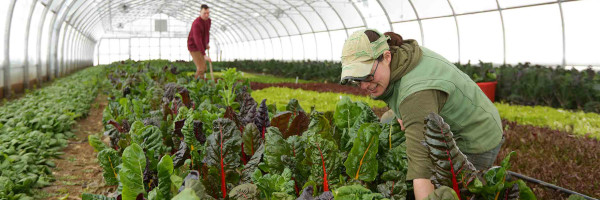Farm to Fork Crop Tracking
| Farm to Fork Crop Tracking | |
|---|---|

| |
 Above: Farm to Fork Farming | |
| Team Organizations | Intel Inc Oregon State University Oregon Department of Agriculture Curry & Company |
| Team Leaders | Shawn Irvine |
| Participating Municipalities | Independence Oregon |
| Status | Concept only Stage |
| Document | [[File:Tech Jam Presentation|Download]] |
Description
Tracking a berry crop at the box, bin, or tote level from harvest in the field to end user. Monitor in near real time temperature, humidity, shock and other environmental conditions to ensure product quality after harvest, throughout transit and during storage.
Potential to use blockchain to ensure authenticity of food safety certification which can travel with each sensor.
Challenges
- Berries are a high value, highly perishable crop
- Buyers increasingly value local sourcing but sellers have few ways to prove provenance
- No solutions currently exist to effectively monitor a crop after harvest but before it enters cold chain custody.
- Monitoring during cold chain is typically at the shipping container, not individual package or pallet level.
- Food safety certification is a cumbersome and imprecise process currently tied to overall shipments, not individual pallets or totes.
Solutions
Solution is a sensor that can be put on or in individual packages or boxes of crop, monitoring location, condition and carrying the required certifications.
More accurate field to fork data could enable “just in time” last mile solutions from urban food hubs.
Major Requirements
- Identify berry growers, cold storage and transportation partners, as well as end users. An ideal partner would be a vertically-integrated berry company.
- Identify effective harvest quantities to provide a quality test case for one or multiple chains of custody (fresh to market, field to food processor, etc.)
- Determine critical data to collect and optimal moment to apply sensors during harvest
- Activate and deploy sensors in the field during June 2018 berry harvest.
- Track crop location and condition in field and through transport to end user.
- Produce crop freight information on a customer-focused dashboard.
Option to include blockchain authentication of food safety certification paperwork which travels with each sensor.
Performance Targets
| Key Performance Indicators (KPIs) | Measurement Methods |
|---|---|
|
Certification will be run concurrently with the existing protocols to avoid accidential lapses and ensure the new process can address all normal certification points. Sensor deployment can be used to estimate labor time saved (staff time spent testing pallets in cold storage by hand), and crop loss avoided (typical losses in transit from refer trucks set to warm or cold). |
Standards, Replicability, Scalability, and Sustainability
- Sensors are currently developed and can be acquired and deployed in varying quantities depending on the scale and budget of the pilot project.
- Partners include Oregon Department of Agriculture’s certification specialists who have an interest in developing new, better systems to authenticate and trace crops.
- Grant funding is being pursued through Oregon State University and Oregon Department of Agriculture to scale this project to multiple additional berry crops in 2019.
- Project is partnering with Curry & Co., a vertically-integrated food packing company to ensure grower and business needs are met, resulting in a more commercially viable product.
Cybersecurity and Privacy
- Sensors will only be applied in fields of willing partners, and will track data about crops not people.
- Data will be transmitted from the sensors through a cellular signal, and will utilize encryption.
- If the system were to be hacked, minimal damage could be done as the sensors are simply monitoring environmental conditions.
By incorporating blockchain technology, we can ensure better tracking of individual pallets, verify their provenance, including organic or other certifications, and even create permission levels so that certification technicians can access certain data, warehouse workers other data, and even allow retail buyers to access information like which farm it came from and imagery of the plant where the crop was processed
Impacts
Ensuring quality of a berry crop from harvest to end user would reduce wastage and enable farmers to charge a premium for their product. Tracing crop location could also become the basis of a logistics network connecting smaller farmers and enabling them to aggregate loads for larger buyers. This would open new markets for small farmers, increasing profitability. With sensors traveling at the individual package level, food safety and other certifications - like organic- can travel with the crop, ensuring authenticity and traceability in the case of a recall.
Demonstration/Deployment
We could offer a demonstration of the sensors, the data they collect and the ways they can be attached at the small package level. A description of the pilot project could also be offered through a presentation or display board.